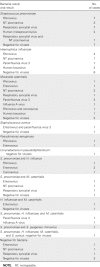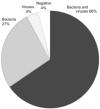Microbiology of acute otitis media in children with tympanostomy tubes: prevalences of bacteria and viruses
- PMID: 17083014
- PMCID: PMC7107988
- DOI: 10.1086/509332
Microbiology of acute otitis media in children with tympanostomy tubes: prevalences of bacteria and viruses
Abstract
Background: Bacteria are found in 50%-90% of cases of acute otitis media (AOM) with or without otorrhea, and viruses are found in 20%-49% of cases. However, for at least 15% of patients with AOM, the microbiological etiology is never determined. Our aim was to specify the full etiology of acute middle ear infection by using modern microbiological methods concomitantly for bacterial and viral detection.
Methods: The subjects were 79 young children having AOM with new onset (<48 h) of otorrhea through a tympanostomy tube. Middle ear fluid samples were suctioned from the middle ear through the tympanostomy tube. Bacteria were sought by culture and polymerase chain reaction; viruses were analyzed by culture, antigen detection, and polymerase chain reaction.
Results: At least 1 respiratory tract pathogen was noted in 76 children (96%). Bacteria were found in 73 cases (92%), and viruses were found in 55 (70%). In 52 patients (66%), both bacteria and viruses were found. Bacteria typical of AOM were detected in 86% of patients. Picornaviruses accounted for 60% of all viral findings.
Conclusions: In the great majority of children, AOM is a coinfection with bacteria and viruses. The patent tympanostomy tube does not change the spectrum of causative agents in AOM. A microbiological etiology can be established in practically all cases.
Figures
Comment in
-
Acute otitis media is not a pure bacterial disease.Clin Infect Dis. 2006 Dec 1;43(11):1423-5. doi: 10.1086/509329. Epub 2006 Oct 31. Clin Infect Dis. 2006. PMID: 17083015 Free PMC article. No abstract available.
Similar articles
-
Acute otorrhea in children with tympanostomy tubes: prevalence of bacteria and viruses in the post-pneumococcal conjugate vaccine era.Pediatr Infect Dis J. 2015 Apr;34(4):355-60. doi: 10.1097/INF.0000000000000595. Pediatr Infect Dis J. 2015. PMID: 25764097 Clinical Trial.
-
Comprehensive Detection of Respiratory Bacterial and Viral Pathogens in the Middle Ear Fluid and Nasopharynx of Pediatric Patients With Acute Otitis Media.Pediatr Infect Dis J. 2019 Dec;38(12):1199-1203. doi: 10.1097/INF.0000000000002486. Pediatr Infect Dis J. 2019. PMID: 31738334
-
Bacterial and Respiratory Viral Interactions in the Etiology of Acute Otitis Media in HIV-infected and HIV-uninfected South African Children.Pediatr Infect Dis J. 2015 Jul;34(7):753-60. doi: 10.1097/INF.0000000000000733. Pediatr Infect Dis J. 2015. PMID: 25923426 Free PMC article.
-
Presence of viral nucleic acids in the middle ear: acute otitis media pathogen or bystander?Pediatr Infect Dis J. 2012 Apr;31(4):325-30. doi: 10.1097/INF.0b013e318241afe4. Pediatr Infect Dis J. 2012. PMID: 22173136 Free PMC article. Review.
-
What is new in otitis media?Eur J Pediatr. 2007 Jun;166(6):511-9. doi: 10.1007/s00431-007-0461-8. Epub 2007 Mar 16. Eur J Pediatr. 2007. PMID: 17364173 Free PMC article. Review.
Cited by
-
The yield of respiratory viruses detection testing is age-dependent in children with acute otitis media.Ther Adv Infect Dis. 2019 Nov 19;6:2049936119871127. doi: 10.1177/2049936119871127. eCollection 2019 Jan-Dec. Ther Adv Infect Dis. 2019. PMID: 31798867 Free PMC article.
-
Contemporary concepts in management of acute otitis media in children.Otolaryngol Clin North Am. 2014 Oct;47(5):651-72. doi: 10.1016/j.otc.2014.06.006. Epub 2014 Aug 1. Otolaryngol Clin North Am. 2014. PMID: 25213276 Free PMC article. Review.
-
Safety, Immunogenicity, Efficacy and Effectiveness of Inactivated Influenza Vaccines in Healthy Pregnant Women and Children Under 5 Years: An Evidence-Based Clinical Review.Front Immunol. 2021 Oct 6;12:744774. doi: 10.3389/fimmu.2021.744774. eCollection 2021. Front Immunol. 2021. PMID: 34691051 Free PMC article. Review.
-
A cooperativity between virus and bacteria during respiratory infections.Front Microbiol. 2023 Nov 30;14:1279159. doi: 10.3389/fmicb.2023.1279159. eCollection 2023. Front Microbiol. 2023. PMID: 38098657 Free PMC article. Review.
-
Moraxella catarrhalis Might Be More Common than Expected in Acute Otitis Media in Young Finnish Children.J Clin Microbiol. 2016 Sep;54(9):2373-9. doi: 10.1128/JCM.01146-16. Epub 2016 Jul 13. J Clin Microbiol. 2016. PMID: 27413187 Free PMC article.
References
-
- Bluestone CD, Stephenson JS, Martin LM. Ten-year review of otitis media pathogens. Pediatr Infect Dis J. 1992;11:7–11. - PubMed
-
- Mandel EM, Casselbrant ML, Kurs-Lasky M. Acute otorrhea: bacteriology of a common complication of tympanostomy tubes. Ann Otol Rhinol Laryngol. 1994;103:713–8. - PubMed
-
- Chonmaitree T, Howie VM, Truant AL. Presence of respiratory viruses in middle ear fluids and nasal wash specimens from children with acute otitis media. Pediatrics. 1986;77:698–702. - PubMed
-
- Pitkäranta A, Virolainen A, Jero J, Arruda E, Hayden FG. Detection of rhinovirus, respiratory syncytial virus, and coronavirus infections in acute otitis media by reverse transcriptase polymerase chain reaction. Pediatrics. 1998;102:291–5. - PubMed
-
- Ruohola A, Heikkinen T, Meurman O, Puhakka T, Lindblad N, Ruuskanen O. Antibiotic treatment of acute otorrhea through tympanostomy tube: randomized double-blind placebo-controlled study with daily follow-up. Pediatrics. 2003;111:1061–7. - PubMed
Publication types
MeSH terms
LinkOut - more resources
Full Text Sources
Other Literature Sources
Medical



